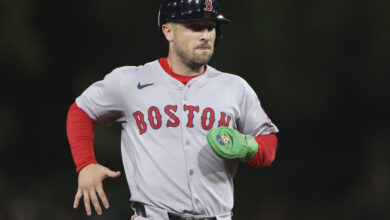
Isaac Paredes Can Improve Results with ‘Simple’ Fix, Just Won’t Be Easy
Isaac Paredes was a bit of a disappointment following the surprising trade that brought him to Chicago in exchange for Christopher Morel, Hunter Bigge, and Ty Johnson, but the Cubs weren’t really counting on him to carry them into the postseason. I was somewhat skeptical of the deal at the time because it felt like a lateral move that saw the Cubs exchange higher ceilings for a higher floor, particularly when the player they acquired appeared to be a poor fit at Wrigley Field. While it’s a mild stretch to say I view Paredes with even cautious optimism, Jed Hoyer believes the third baseman will rebound.
“I guess I would ask, why wouldn’t it be?” Hoyer responded when asked about the expectation that Paredes will regain the form he flashed in Tampa. “He has a really good track record.”
Well, Jed, one of the reasons he wouldn’t be expected to perform as well at his new home — where he posted a -2 wRC+ with just one extra-base hit in 96 plate appearances — is the left-field wall that’s 40 feet deeper than at Tropicana Field. As Driveline senior hitting trainer Justin Sartori laid out, Paredes hit 11 homers at the Trop over the last two seasons that traveled 370 feet or less down the left field line.
Adjustments to Wrigley:
The trade to the Cubs put Paredes in a unique position. Wrigley Field’s deeper corners compared to Tropicana Field posed a challenge for Paredes’ existing batted ball profile. Tropicana’s friendlier pull-side dimensions allowed more fly balls to result in… pic.twitter.com/2tIs8hz4Ui
— Justin Sartori (@JustinS626) November 7, 2024
That might seem insignificant until you consider it represents roughly 41% of all the homers he hit in Tampa over 2023 and ’24. Just being a right-handed hitter with extreme pull-side tendencies would make things tough enough at Wrigley on its own, but now we also have to consider how the wind impacts the fly balls he hits at a high rate. Over the last two seasons, only nine other qualified hitters rank above Paredes and his 46.4% fly-ball rate. While that’s not necessarily a bad thing in and of itself, it becomes an issue with the way the wind blew in so often last season.
The third layer in this cake of concern is Paredes’s sixth-percentile hard-hit rate and seventh-percentile bat speed. Those issues with the wind and distance can’t be overcome by a player who doesn’t hit the ball very hard. That’s where we turn back to the X thread above from Sartori, who posited that a 3 mph increase in bat speed would yield a significant improvement.
I know that’s a touchy subject for folks who eschew context and say “Bat speed bad!” or whatever, but we’re talking about a hitter with very strong bat-to-ball skills and swing decisions. All things being equal, swinging harder would create better contact. Paredes did make adjustments to his swing after joining the Cubs, notably decreasing his launch angle and hitting more line drives with fewer grounders. Now he just needs to figure out how to juice that up a little bit.
He and the Cubs really need to get those power numbers up because, barring a surprise addition or a breakout performance elsewhere, that’s a big reason he acquired. The problem is that Paredes needs to hit 30+ homers to have an impact, and Sartori’s numbers indicate that even getting to around league average bat speed of 71.5 mph (Paredes was at 68.2 mph last year, tied for 194th in MLB) would translate to approximately 20 dingers. So the first big question is whether he can even make such an improvement and the second is whether it’ll matter.
That kind of jump in bat speed might not seem doable in most cases, but Paredes clearly has some room to grow and league average isn’t a huge ask. It’s the end result that worries me a great deal more, as having a third baseman who’s only hitting 20 longballs isn’t going to help much unless he’s earning a platinum glove. And though he should be better than what he showed with the Cubs, not to mention the player(s) he replaced, Paredes isn’t likely to win any fielding awards anytime soon.
Call it a bias toward Matt Shaw or a need to be right if you like, but I just don’t see Paredes making the kind of improvement that’s meaningful enough to serve as a rising tide for the Cubs. Not that they should be depending on him to be the man or anything, it’s just that Hoyer has talked a lot about having players outperform their projections to get to 90 wins and compete for titles. Paredes went in the opposite direction — something that could benefit his hitting — following the trade and is going to need to do quite a bit better in ’25 just to meet projections.
This is something I want to keep a close eye on during spring training and the start of the new season, assuming Paredes is still with the team.

